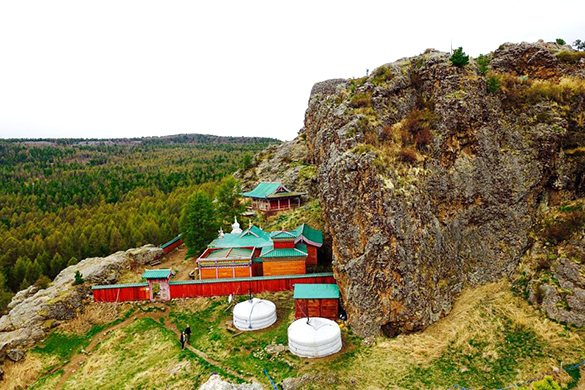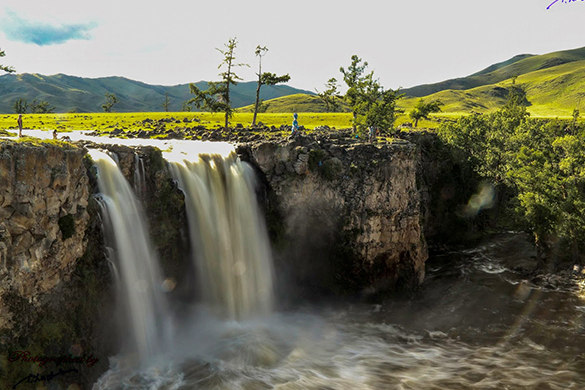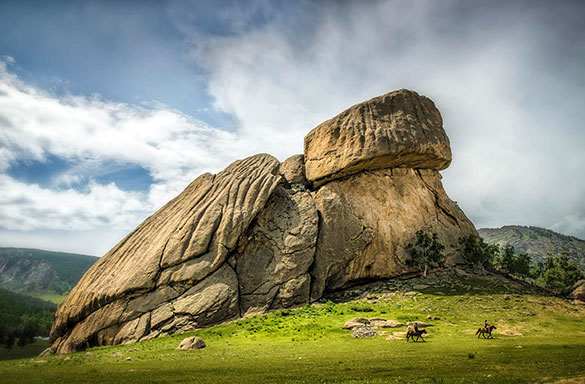
Amazing green world will attract everyone there with outstanding landscapes such as forests, Hangai mountain ranges, volcanoes, bright lakes and longest rivers. Besides, it is also a world of flowers as flora boasts a high diversity. These plants consist of different magnificent scenes due to here, the Siberian Taiga meets with the Mongolian steppe as the southern edge of the Taiga are gradually replaced by forest steppe and to the south by steppes. This is green jade of central Mongolia as well as dwelling area for yaks, horses, goats and sheep. Ranked as one of the top mountain steppe, Hangai is well-protected, and stretches about 700km from northwest to southeast, parallels the Mongol Altai mountains (south). The various eco-system keeps several animal species such as Shaker Falcon, Swan Goose, Pallas, Fish-Eagle, Siberian Mask Deer and Argali sheep. Areas of special importance for the preservation of plant, animal species, the functioning of eco-systems and particular landscape beauty have been designed as protected areas.
KHUSTAI NATIONAL PARK
This magnificent area is official declared a specially protected area in 1992, and its became a home to Takhi- wild horses. Takhi horses were actually extinct in the wild in the mid of 1960’s. After some successful conservation program reintroduced by a group from Netherlands in the frame of international project, the first 15 wild horses were selected for reintroduction into Mongolia in 1992. As the aims of the breeding program, Hustai National Park has re-established wild Przewalski’s horses in the natural environment. A total of 84 horses representing as broad a genetic basis as possible were reintroduced to the wild through being placed in Hustai National Park.
KHARKHORIN AND ERDENEZUU MONASTERY
Kharakhorum was the most important city in the history of world trade holding during the 13th century and, former residents of those who once ruled Mongolia established capital city in 1220. About 40 years, this was the center of one of the most powerful empires in the world and everything was controlled from here. The city had a surrounding wall with four stone turtles which used to symbolize longevity and solidarity of the city have been left as a little to see. However, a few mysterious sites remain which along with Erdenezuu monastery is a highly evocative of this ancient city in central Mongolia. Of those glorious time almost nothing has survived.
TUVKHUN TEMPLE
In Buddhist culture, mountain tops are believed to enlighten people and bring them closer to the gods. The hermitage monastery of Tuvkhun is located on the rocky hill of Undur Shireet mountain and its surrounded by beautiful scenic at the altitude of 2300meters above sea level. In 1653, One of the oldest monastery of Tuvkhun was skillfully erected by Zanabazar who was the spiritual head of Mongolian Buddhismin a small-sized area between naturally impressive rocks. Noble Holiness Zanabazar created his great art works and invented his Soyombo script in this monastery. He built a stone-walled small house to practice meditation due to mountain top has provided inspiration to worshippers.
Lush green Orkhon valley encompasses an extensive area of pastureland on both banks of Orkhon river like blue snake flowing in the middle and includes numerous archaeological remains from imperial Mongol power dating back to the sixth century C.E. In the history of central Asia, Orkhon valley served as the seat of the imperial power of the nomads and pastoral societies. Orkhon river rises from the heavily forested slope of the Hangai mountain range and flows to Selenge river with length of 1125 kilometers. In 2004, Orkhon valley was recognized by the UNESCO World Heritage as cultural landscape due to a home for centuries to major political, trade, cultural religious activities of successive nomadic empire.
Extinct Horgo volcano is located on the east shore of White lake in the northern part of Hangai mountain ranges at the altitude of 2210 meters above sea level. The volcano erupted 8000 years ago as a last active volcano and its surrounding by lava field and basalt rocks. Volcano eruption resulted a crater with 200m radius and 100 deep. From the summit of this basalt-covered mountain and endangered species of flora and fauna with volcano crater has been protected since 1997. White lake is formed when an immense mass of hot- lave once blocked the bed of river Terkhi. In the area of 61 square kilometers, its water formed beautiful lake, 20km long, 16km wide and 4 meters deep with an altitude of 2060m above sea level.
TERELJ NATIONAL PARK
The Park is situated at 70kms, northeast of Ulaanbaatar. It takes nearly two hours drive from the capital. The park lies at 1600 meters high and offers great opportunities for hiking, horse riding and rock climbing. The landscape is similar to the Alp’s. It is a national park which started to develop since 1960's and officially was designed as a National Park in 1994. Inside the park, there are ranges of protected animals such as birds (250 species), moose, and bears. As it is become developed for tourism, some of the Ger camps have car parking and electricity. Most of the tourist camps work only summer seasons, a few of them operate whole year around.





